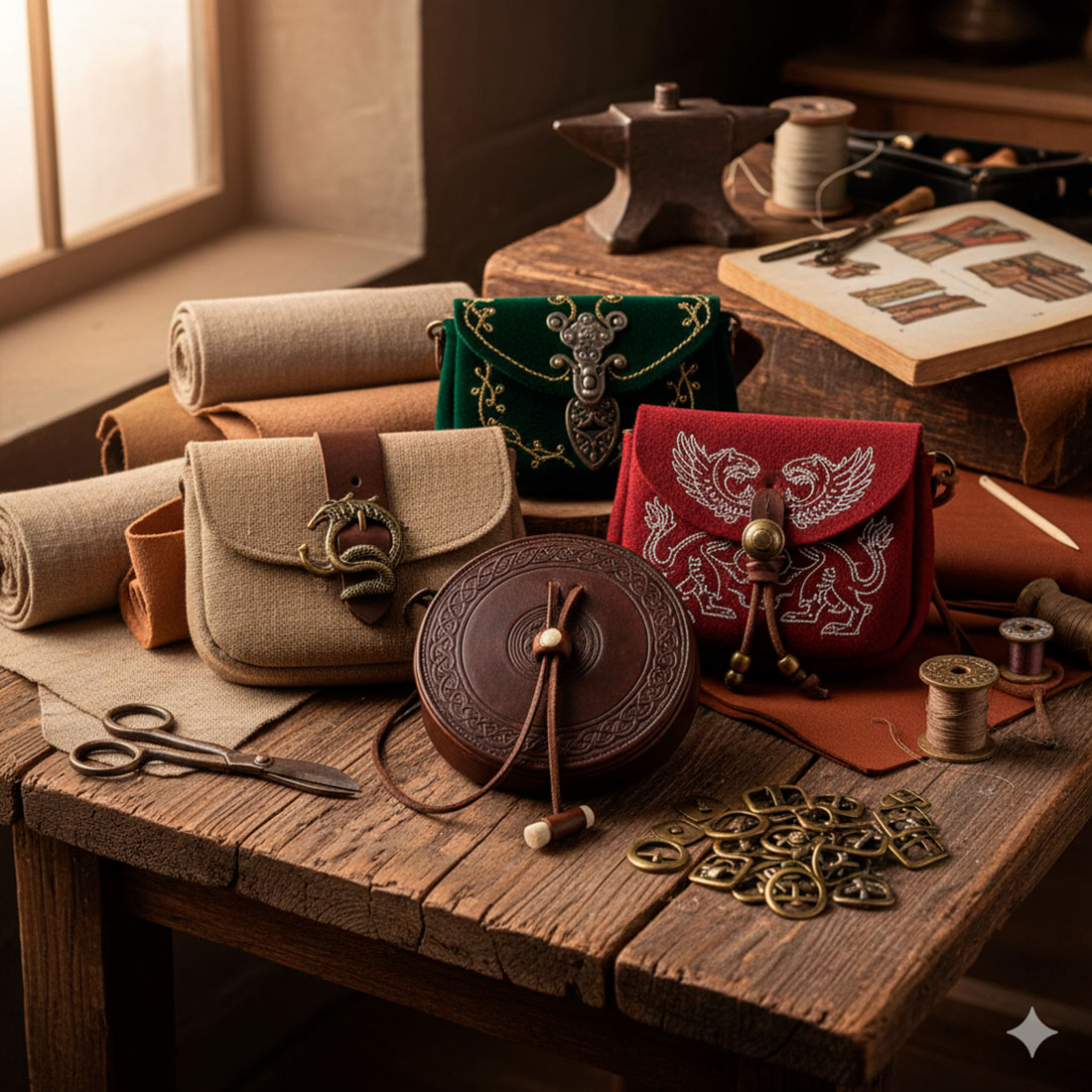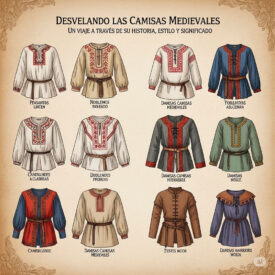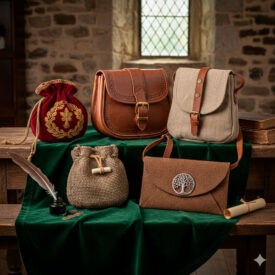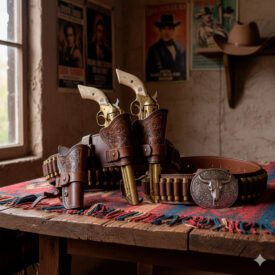Imagine a world without pockets, where every personal item had to be carried with ingenuity and style. In the Middle Ages, this was the reality, and it is here that the belt bag, then known as an alms purse or pouch, forged its legend. More than a simple accessory, it was a vital necessity, an inseparable companion for travelers, merchants, and knights. Today, for historical reenactment enthusiasts, the medieval belt bag is the bridge that connects the present with an epic past, not only for its practicality, but for the profound value of authenticity it embodies.
From the Belt Pouch to the Fanny Pack: A Historical Journey
The practice of carrying personal items attached to the waist—from prehistoric bags to the contemporary fanny pack—has been constant and has adapted to technological, social, and fashion changes. Below is a summarized chronology of its evolution.
| Era | Event |
|---|---|
| I. Ancient Origins (c. 3300 BCE – 5th Century CE) | |
| c. 3300 BCE (Prehistory) | The use of bags tied to the waist is documented; Ötzi the Iceman’s mummy was found with a belt containing a pouch for storing belongings. |
| Antiquity | Egyptian hieroglyphs show men with bags at their waists; in Greek mythology, Perseus carries a pouch on his mission; Native Americans used buffalo hide bags tied to their garments. |
| Iron Age (Celtic Peoples) | Celts used a small “pouch” tied to the belt, made of leather or wool and often adorned with metals, to carry personal items and jewelry. |
| II. The Middle Ages: The Alms Purse and Belt (5th–15th Centuries) | |
| 9th Century (Vikings) | Bags like the Birka Pouch, generally made of leather and worn at the belt, used by Vikings and populations in northern and central Europe. |
| Late 9th – Early 10th Century (York) | Anglo-Scandinavian finds: remnants of footwear and the use of “coffee-bean toggle” type fasteners also employed in other securing accessories. |
| c. 930/5–c. 975 and 10th–11th Centuries | Popularity of footwear fastened with toggles and flaps; material context accompanying the use of waist bags in the region. |
| Medieval Era (general) | The term alms purse/coin purse emerges: small bags attached to the belt for alms or everyday objects (rosaries, combs, handkerchiefs). Used by men and women, made of luxurious fabrics or humble materials according to status. |
| 13th Century | In art, representations of bags tied to the waist (tasses/tassettes) that replaced pockets multiply; they were tied with cords. |
| 14th Century | Differentiation: leather belt bag (men) and hanging bags with a strap or hanger (both sexes of high class). The alms purse could be closed with a drawstring. |
| 15th Century (Andalusia) | Existence of barjoletas: leather containers (goat or Cordovan leather) closed with padlocks and keys; common leather and baldrés bags were also used. |
| III. Beginnings of Modernity and Transition to the Handbag (16th–19th Centuries) | |
| 16th Century | Fashion with voluminous dresses made it difficult to carry visible coin purses; inner pockets appeared in dresses; men incorporated sewn pockets. |
| 17th Century | Consolidation: men with integrated pockets; women with detachable pockets hidden under petticoats, accessible through openings (large, up to 40 × 30 cm). |
| Late 18th Century (Empire Style) | Shirt dress fashion precluded hidden pockets; the reticule (reticŭlus) emerged in France: a small visible handbag. |
| Early 19th Century | The reticule (ridículo in Spain) became a common female accessory, carried from the wrist or tied with cords; its visibility was considered scandalous by some sectors. |
| 1828 | Documentation in London of the term châtelaine for chains of accessories hanging from the belt (derived from the function of carrying keys). |
| Mid–late 19th Century (c. 1860–1880) | Popularity of the châtelaine bag, associated with the bustle fashion and the enhancement of the waist/hips; embroidered silk models appeared around 1880. In Spain, terms like escarcela or limosnera (1870–1880) were used. |
| Late 19th Century – 20th Century (Modern Antecedents) | Evolution towards handbags and hanging pieces that continued the practical function of waist bags, foreshadowing modern forms of carrying objects. |
| IV. Contemporary Era (Late 20th Century – 21st Century) | |
| Late 20th Century (1980s–1990s) | The modern fanny pack reached its peak of popularity: compact design for waist/hips and practical use for money and personal items; it was widely associated with tourism and leisure. |
| Late 20th Century – Early 21st Century | After its heyday, the fanny pack fell into popular disrepute, becoming a stereotype of the unfashionable tourist. |
| Recent Years | Resurrection as retro and ironic fashion: the fanny pack regained popularity among young people and reappeared in high fashion collections; in addition to waist/hip use, wearing it cross-body over the chest or back became popular. |
The Essence of Authenticity: Genuine Materials in Medieval Belt Bags
For the re-enactor, the quest for authenticity is a constant journey. At the heart of every medieval belt bag are the materials, silent witnesses to the craftsmanship of an era. Leather, linen, and cotton, worked with techniques passed down through centuries, not only offer a faithful aesthetic but also the strength and durability that defined these objects in their time.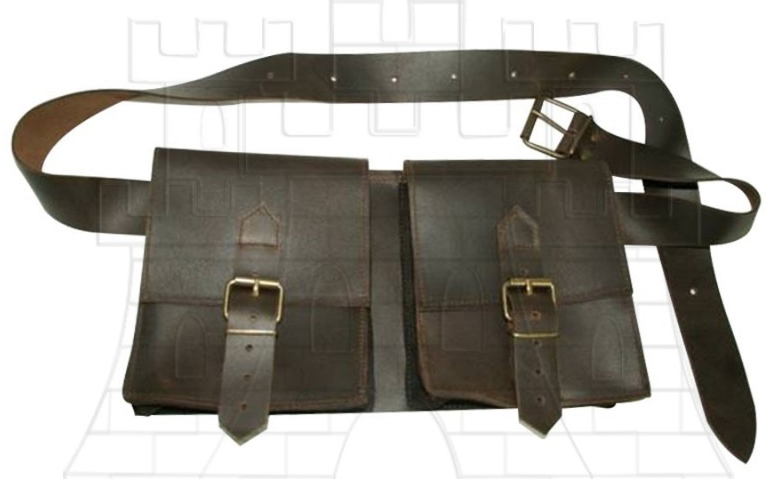
Leather: Resistance and Historical Legacy
Leather was the material par excellence in the Middle Ages for bags and belt pouches. From the robustness of porcine leather in Viking pieces to the softness of Cordovan leather (tanned goatskin) in Andalusian barjoletas, its versatility was unmatched. Vegetable tanning methods with tannins extracted from plants ensured a durability that we emulate today with deep respect. Replicas like the Birka Viking pouch, with its Magyar motifs and clasp strap, speak to us of a past where every detail had meaning.
Natural Fabrics: Linen, Cotton, and Wool
Although leather predominated, natural fabrics also had their place. Linen and cotton offered breathability and a lightness that complemented medieval attire. In some cases, sheep’s wool was used, especially in Celtic “pouches,” adding texture and warmth. These materials were not only chosen for their availability but for their ability to be shaped and adorned with embroidery or metallic elements that reflected the social status of their wearer.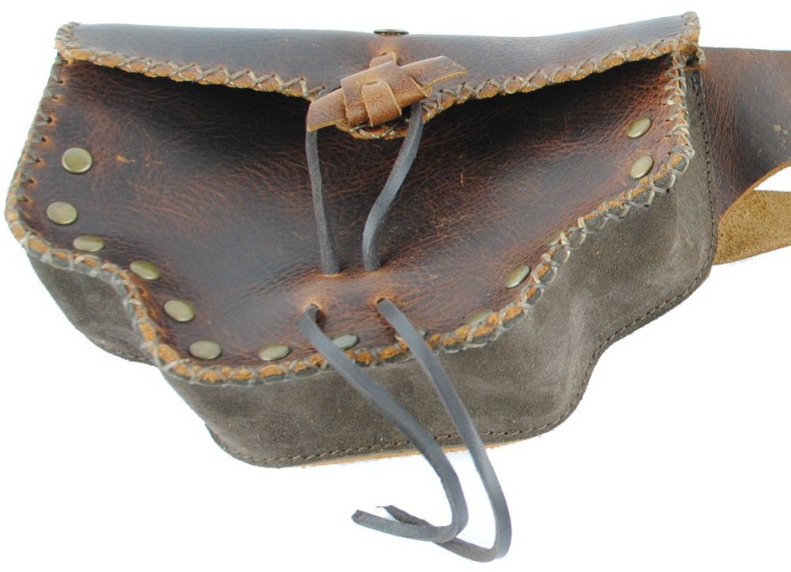
Design and Craftsmanship: Marks of Artisanal Mastery
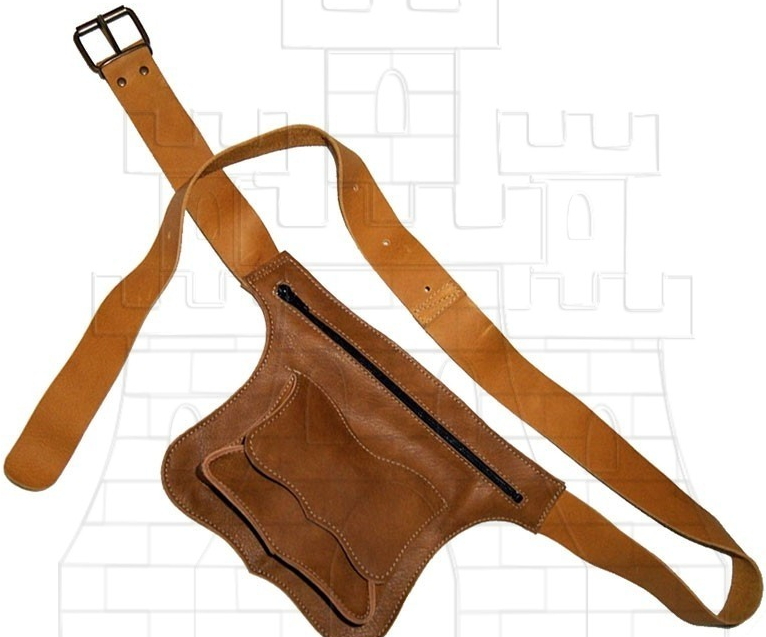 Medieval belt bags were functional pieces, but also works of art. Their design varied from simple sacks tied to the belts of peasants to richly ornamented pieces for the nobility. Iron locks with keys on barjoletas, silk, gold, or silver buttons, and heraldic or nature-inspired embroidery adorned the bags of the more affluent. In the 13th century, even fastening buttons became decorative elements, adorning bags with red, green, white, or black pigments.
Medieval belt bags were functional pieces, but also works of art. Their design varied from simple sacks tied to the belts of peasants to richly ornamented pieces for the nobility. Iron locks with keys on barjoletas, silk, gold, or silver buttons, and heraldic or nature-inspired embroidery adorned the bags of the more affluent. In the 13th century, even fastening buttons became decorative elements, adorning bags with red, green, white, or black pigments.
Belt Bags Today: Authenticity and Reenactment
In the world of historical reenactment and LARP, authenticity is key. Modern belt bags for these events seek to faithfully replicate original designs and materials, based on archaeological evidence and guild texts. Although more economical synthetic leather options exist, true enthusiasts value pieces made with traditionally treated leather, linen, or cotton, which not only capture the aesthetic essence but also the feel and durability of a genuine piece from the past.
In addition to historical fidelity, current belt bags for reenactment also prioritize comfort and functionality. Adjustable straps, ergonomic designs, and compartments adapted to modern needs (for cell phones or keys, for example) are carefully integrated without sacrificing medieval aesthetics. It’s a balance between historical rigor and 21st-century practicality.
Resolve your doubts about medieval and modern belt bags
What are the most common materials for making medieval belt bags?
The most common materials for making medieval belt bags were leather and natural fabrics such as linen and cotton. Leather was primarily used for its durability and resistance, while natural fabrics provided texture and functionality, such as breathability and some resistance. Wool was also common in medieval outerwear, though for bags and belt bags, leather and linen predominated.
What tanning techniques were used in the Middle Ages?
In the Middle Ages, tanning techniques were primarily based on vegetable tanning with tannins, using extracts from plants such as oak galls, oak bark, and sumac to transform hides into durable and resistant leather. The process included several stages: soaking to clean and rehydrate, liming with milk of lime to loosen fibers and remove hair, scraping to remove remnants of fat and flesh, followed by immersion in tannin baths for tanning.
Treatments with fats and oils were also used to waterproof and soften the leather, and alkaline solutions and laurels were employed to remove hair, sometimes with the aid of manure to soften the hides.
This work was carried out in specialized workshops that bought untanned hides, cleaned, prepared, and tanned them using this multi-stage, labor-intensive but effective artisanal method to produce usable leather for clothing, footwear, armor, and everyday objects. Additionally, natural dyes were applied to color the leather.
The medieval tanning techniques included:
- Soaking in water for cleaning and rehydration
- Liming with milk of lime to remove hair and epidermis
- Mechanical scraping to remove flesh and fat
- Vegetable tanning with plant tannins (galls, oak, sumac)
- Application of fats and oils to soften and waterproof
- Dyeing with natural pigments for coloring
These techniques formed the basis for leather production in the Middle Ages, regulated by guilds and developed within specialized workshops.
How did medieval artisans ensure the authenticity of their products?
Medieval artisans ensured the authenticity of their products through manual craftsmanship using traditional techniques passed down through generations, maintaining artisanal secrets, and paying special attention to the quality, materials, and finishes that reflected their specialized trade. Furthermore, most of the work was done directly by the artisan or with minimal help from family members or apprentices, avoiding mass production or resale to ensure that each piece was unique and genuine. It was also common to present and sell products in markets or fairs where the artisan was present, which facilitated direct verification of the work and authenticity.
What are the differences between medieval and modern belt bags?
The main differences between medieval and modern belt bags can be summarized in the following aspects:
Materials and manufacturing
- Medieval: They were primarily made of leather, fabric, or animal hides (goat, cow), and those of greater wealth could include silk embroidery, gold, silver threads, and precious stones. Craftsmanship was artisanal, using traditional techniques and natural materials.
- Modern: Leather, synthetic leather, canvas, and other industrial textiles usually predominate. The use of synthetic materials and industrialized manufacturing processes allows for variety and lower cost.
Design and aesthetics
- Medieval: Their function was as important as their social status, so there were simple models for commoners and others highly ornamented for nobility, with heraldic motifs, embroidery, and decorative elements. Shapes were basic, generally in the form of a sack or small pouch, and were worn hanging from the belt or with a leather strap.
- Modern: The design is much more varied and functional, adapting to urban and sports uses. Simplicity and technology predominate, with secure closures, multiple pockets and compartments, and practical details like adjustable straps and reflective elements.
Function and use
- Medieval: Their primary function was to store coins and small personal items, especially during travels or in daily life. The use was both practical and symbolic, reflecting the social position of the wearer.
- Modern: In addition to carrying personal items, they integrate technological functions (compartment for mobile phones, USB, electronic devices) and are designed for sports activities, festivals, travel, and daily urban use, prioritizing comfort and security.
Medieval belt bags were leather or fabric accessories, artisanally crafted and differentiated by social status, while modern ones respond to mass industry, technology, and contemporary lifestyle, offering greater functionality, variety of materials, and designs adapted to new uses.
What role did belt bags play in medieval daily life?
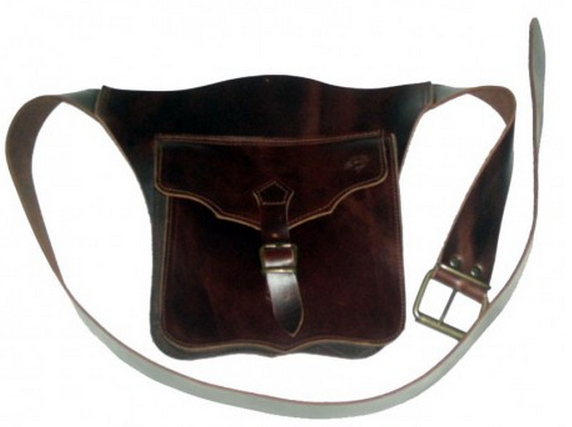 Belt bags played a fundamental role in medieval daily life as a practical solution to the problem of carrying personal items, as clothing of the time generally lacked pockets. These small bags, usually made of leather or fabric, were attached to the belt and allowed for carrying things like money, documents, keys, or small belongings, keeping hands free, which was especially useful for travelers, artisans, and merchants.
Belt bags played a fundamental role in medieval daily life as a practical solution to the problem of carrying personal items, as clothing of the time generally lacked pockets. These small bags, usually made of leather or fabric, were attached to the belt and allowed for carrying things like money, documents, keys, or small belongings, keeping hands free, which was especially useful for travelers, artisans, and merchants.
In addition to their practical function, belt bags could also be a reflection of social status: while peasants used simple and functional models, nobility often carried more elaborate designs and higher quality materials, even decorating their bags with fabrics like velvet or metal details. Thus, the belt bag was not only an everyday accessory but also a symbol of distinction and personal taste.
“The medieval belt bag is much more than a simple accessory; it is a tangible portal to a past where functionality merged with personal expression and status. For the reenactor, understanding its materials, evolution, and significance is fundamental to building an authentic representation of medieval life. Thus, equipped with knowledge and the perfect replica, they will be able to walk in the footsteps of history, reliving the essence of a legendary era.”
VIEW MEDIEVAL LEATHER BAGS | VIEW MEDIEVAL ALMS PURSES | CELTIC BAGS | VIKING BAGS
